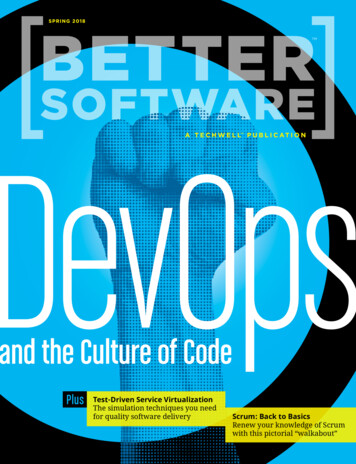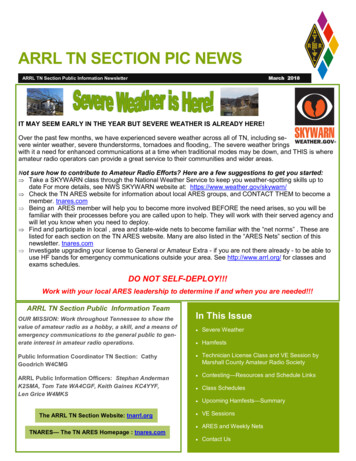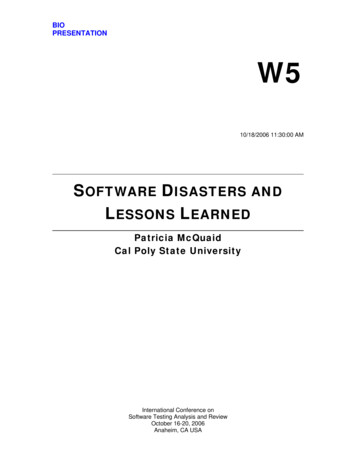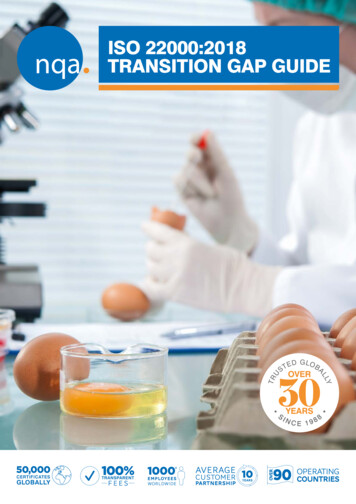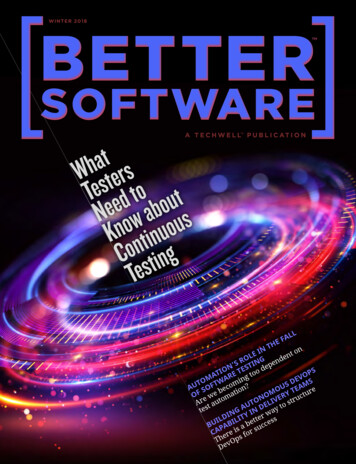
Transcription
WIN TER 2018LLFAEHTnINtoEnLO GdeS R TIN epen’N ESdPSTIO RE T tooOAgVMAnETO TW miS D AMSUAU SOF beco ion?EMO RY T ctureOF e we matOEuNoTO ELIV to strAr t autUD yAtesNG Y IN r waIILD LIT tte ssBU PABI a be uccesCA ere i for sTh vOpsDe
What are Past Attendees Saying?about the TOPICSabout the KEYNOTES“I very much enjoyed beingable to cross-attend thevarying topics to gain alarge content of ideas.”“The keynotes were inspiring! Therewere several practical talks. Gave metime to think and network to developactionable takeaways.”Tim Robert, Systems Analyst,State FarmPete Lichtenwalner, Sr. Engineer Manager, Verintabout the TUTORIALSabout the SPEAKERS“Great speakers that show they arepassionate about what they do. Plus theyare open to share ideas and experiences.”Verita Sorsby, QA Manager, Tio Networks“Excellent conference. Thetutorials were invaluable tome and my group.”Jennifer Winkelmann, BusinessAnalyst, TD AmeritradeAgile Dev topic areas:Better Software topic areas:DevOps topic areas: Scaled Agile Development Agile Testing Agile Implementation Career & Personal Development Agile Teams & Leadership And More Architecture & Design Configuration Management DevOps and Test/QA Continuous Delivery Continuous Integration And MoreDigital TransformationProcess & MetricsSoftware Quality & TestingRequirements & User StoriesProject ManagementAnd MoreJUNE 3–8, 2018LAS VEGAS, NVCAESARS PALACERegister byApril 4, 2018with code CWBSMto save up to 800 off yourconference*TO REGISTER CALL 888. 268.8770 BSCWEST.TECHWELL.COM*Discount valid on packages over 400
x.ecordItemIndex(1));equence 'admin'.", new RecordItemIndex(2));
SAVE THE DATE FOR THE INAUGURAL EVENT!JUNE 25–29, 2018BOSTON, MAEurope’s fun and widely popular agiletesting festival is coming to NorthAmerica as Agile Testing Days USA. Thisevent will feature over 50 of the top agiletesting enthusiasts speaking in Boston.https://agiletestingdays.usSUPER EARLYLOBSTERSAVINGSWHEN YOUREGISTER BYAPRIL 27, 2018
On the CoverWhat Testers Need toKnow about ContinuousTestingIN SID EThanks to the trend towardDevOps and continuousdelivery, traditional testingisn’t enough. Including testVolume 20, Issue 1automation in your strategy isWINTER 2018a good start, but your testingapproach needs to change.13Features18by Wayne Ariola2327Agile outside the DevelopmentTeamAutomation’s Role in the Fall ofSoftware TestingBuilding Autonomous DevOpsCapability in Delivery TeamsMost developers have tough encounterswith business-oriented nondevelopers.An expert business analyst shows howan understanding of each others’perspective will result in project success.by Ron HealyHas the rise in test automation resultedin product releases of lesser quality?Besides adopting more comprehensiveautomated scripting, there are processand organizational dynamics toconsider. by John TysonAfter setting up a DevOps team andadopting continuous delivery practices,product releases may not be as smoothas they could be. The missing ingredientrequires empowerment and autonomy.by Miiro JuusoColumns09DepartmentsTECHNICALLY SPEAKING5 Ways to Pair Developers withTestersSome agile practices stress theimportance of pairing team memberstogether to achieve better teamperformance. Try these five suggestionsfor pairing key resources.by Jeffery Payne32THE LAST WORDAdopt an Innovative QualityApproach to TestingHow much testing is really enough?Given resources, budget, and time,the goal of comprehensive testingseems impossible to achieve. It’s timeto rethink your test strategy and startinnovating. by Rajini Padmanaban060708113034Mark Your CalendarEditor's NoteContributorsInterview with an ExpertTechWell InsightsAd IndexBetter Software magazine brings you the hands-on, knowledge-building information you need to run smarter projects and deliver betterproducts that win in the marketplace and positively affect the bottom line. Subscribe today at BetterSoftware.com or call 904.278.0524.BETTER SOFTWARETechWell.com5
M A R K YO U R C A L E N DA RSQE TRAININGAT E C H W E L LHelping organizations worldwide improve their skills, practices,and knowledge in software development and testing.C O M P A N YSoftware Tester Certification—Foundation Levelhttp://www.sqetraining.com/certificationFeb. 27–Mar. 1, 2018Mar. 6–8, 2018Mar. 20–22, 2018Apr. 10–12, 2018Mar. 6–8, 2018Mar. 20–22, 2018Apr. 10–12, 2018May 1–3, 2018Chicago, ILDallas, TXAtlanta, GAWashington, DCSan Jose, CADetroit, MISalt Lake City, UTPhiladelphia, PAAgile Testing Training Weekhttp://www.sqetraining.com/agile-weekFeb. 20–23, 2018Mar. 20–23, 2018Boston, MAChicago, ILConferenceseventsApr. 29–May 4, 2018Orlando, FLLEARN MORECutting-edge concepts, practical solutions, and today’s most relevant topics.TechWell brings you face to face with the best speakers, networking, and ideas.June 3–8, 2018Las Vegas, NVJune 25–29, 2018Boston, MALEARN MORELEARN MORESep. 30–Oct. 5, 2018Oct. 14–19, 2018LEARN MORELEARN MOREAnaheim, CAToronto, ONNov. 4–9, 2018Orlando, FLLEARN MOREBETTER SOFTWARETechWell.com6
EDITOR’S NOTE2018 Is the Year to Trust Your CustomerIn each issue of our magazine we try to provide inspiration for making “better” software. Yet I continue to be discouraged with how software vendors manage end-user licensing. In our industry’s questto protect IP and revenue, vendors often ignore the impact it has on the customer and the end-user.As commercial software apps migrate toward subscriptions, this can be a win for the software provider and a win for the end-user—as long as the app continues to provide value.But the administration imposed by subscription models on end-users and technical support individuals can be painfully irritating. You, as a software developer or tester, may not even hear about it.Most of us have had frustrating experiences attempting to resolve licensing issues. There is a carefulbalance between protecting your company’s investment and simplifying the end-user experience.Designing a trusting, easy-to-administrate software licensing mechanism cannot be an afterthought.Ken Whitakerkwhitaker@techwell.comTwitter: @Software ManiacEnough of my rant. Let’s talk about this issue of Better Software.Our featured article by Wayne Ariola, “What Testers Need to Know about Continuous Testing,”presents a wonderful introduction to how modern testing is changing. By using test automation andfrequent evaluation of business risk, you can determine the best time to deliver.As a practicing business analyst, Ron Healy shows how agile is perceived in “Agile outside the Development Team.” If you are struggling to get nondevelopers to accept your agile practices, this is just the“secret sauce” you need to know. Has the rise in test automation resulted in poor quality? John Tysonseems to think so in his provocative “Automation’s Role in the Fall of Software Testing.” John givesgood advice on how to right the ship. In Miiro Juuso’s “Building Autonomous DevOps Capability inFOLLOW USDelivery Teams” article, you’ll learn the best way to structure your DevOps organization for success.If you haven’t had success providing quality in your software products, consider following JefferyPayne’s advice in “5 Ways to Pair Developers with Testers.” In “Adopt an Innovative Quality Approachto Testing,” Rajini Padmanaban offers new perspective on testing in production.If you like Better Software, please spread the word via Twitter and Facebook. And let us and our authors know what you think of the articles by leaving your comments. We value your feedback.PUBLISHERTechWell CorporationPRESIDENT/CEOWayne MiddletonDIRECTOR OF PUBLISHINGHeather ER SOFTWARE EDITORCREATIVE DIRECTORSALES CONSULTANTSMARKETING MANAGERSPRODUCTION COORDINATORMARKETING ASSISTANTKen WhitakerONLINE EDITORSJamie Bordersjborders.comJosiah RenaudinBeth RomanikDaryll PaivaKim TrottAlex DinneyCristy BirdPatrice JohnsonAllison ScholzPRODUCTION COORDINATORDonna HandforthCONTACT USEDITORS:editors@bettersoftware.comSUBSCRIBER SERVICES:info@bettersoftware.comPhone: 904.278.0524,888.268.8770Fax: 904.278.4380BETTER SOFTWARETechWell.comADDRESS:Better Software magazineTechWell Corporation350 Corporate Way, Ste. 400Orange Park, FL 320737
CONTRIBUTORSWayne Ariola, CMO of Tricentis, is a recognized thought leader on continuous testing, risk-based testing,service virtualization, and API testing. He has been a contributor to the software testing space for more thanfifteen years and in the software industry for more than twenty. Wayne has created and marketed productssupporting dynamic software development, test, and delivery. He has driven the design of many innovativetechnologies and received several patents for his inventions. Reach Wayne at w.ariola@tricentis.com.Ron Healy has had a diverse fifteen-year career as a senior business analyst, product owner, entrepreneur,innovator, lecturer, and corporate trainer. Ron has helped organizations with agile software development,e-commerce, Internet of Things, and legacy modernization. He is a keen proponent of using agile techniquesonly when it makes sense and is a firm believer in lifelong learning. Contact Ron at ronhealyx@gmail.com.Miiro Juuso is a sysadmin turned software engineer, turned salesman, and returned to sysadmin. As theDevOps lead at AND Digital in London, he helps Financial Times Stock Exchange 100 companies build DevOpscapability and deliver better software. In his spare time, Miiro blogs about DevOps tools, methodologies, andpractices (getintodevops.com). Reach Miiro at miiro.juuso@gmail.com.As vice president, Rajini Padmanaban leads the engagement and relationship management for some of QAInfoTech’s largest and most strategic accounts. She has over sixteen years of professional experience, primarily in software quality assurance. Rajini actively advocates software quality assurance through evangelisticactivities including providing insights and blogging on test trends, technologies, and best practices. ContactRajini at rajini.padmanaban@qainfotech.com.A frequent TechWell contributor, Jeffery Payne is CEO and founder of Coveros, Inc. Since its inception in 2008,Coveros has become a market leader in secure agile principles and recognized by Inc. magazine in 2012 as oneof the fastest growing private companies in the country. Jeffery has published more than thirty papers on software development and testing. He has testified before Congress on issues of national importance includingintellectual property rights, cyber terrorism, and software quality. Reach Jeffery at jeff.payne@coveros.com.A longtime freelancer in the tech industry, Josiah Renaudin is now a web-content producer and writer forTechWell Insights, StickyMinds.com, and Better Software magazine. He wrote for popular video game journalism websites like GameSpot, IGN, and Paste Magazine and now acts as an editor for an indie project publishedby Sony Santa Monica. Josiah has been immersed in games since he was young, but more than anything, heenjoys covering the tech industry at large. Contact Josiah at jrenaudin@techwell.com.A software testing and QA professional with more than twenty years of testing experience, John Tyson considers himself fortunate to have worked mostly in agile environments. A proponent of lean software development, John makes extensive use of black box and exploratory testing. His clients include startups, the publicsector, non-profits, Fortune 500, and multi-national corporations. Reach John at jmt research@yahoo.com.BETTER SOFTWARETechWell.com8
TECHNICALLY S PEAKIN G5 Ways to PairDevelopers with TestersTHERE IS AN ART TO TEAM ORGANIZATION, AND YOU’LL GET THE BEST OVERALLQUALITY RESULTS BY PAIRING DEVELOPERS WITH TESTERS.by Jeffery Payne jeff.payne@coveros.comEven though the agile movement is nearly two decades old,either individually or in conjunction with other testers.many organizations still struggle with how to get their develop-Having a developer and tester work together to define accep-ers and testers working together. In my experience, some typestance tests is a great way to get them on the same page. This collab-of software developers, including front-end, business logic, back-oration around each user story results in a clear understanding ofend, and UI/UX designers, have figured out how to comfortablywhat needs to be implemented to satisfy customer needs.work together. However, developers and testers often are moreSome who have been schooled on the importance of indepen-aligned within their functional silos, causing sprints to operatedence between developers and testers may bristle at the idea ofmore like mini-waterfalls than collaborative teams.developers and testers working so closely together to define testUntil this gap between developerscases. In practice, the benefits of thisand testers is closed, teams operatingcollaboration far exceed any dangerlike this will continue to struggle tocomplete estimated work in sprints.Instead of addressing the underlyinggaps between developers and testers,teams often place a bandage on problems by increasing the duration of theirsprints or shifting some portion of thetesting process out into future sprints.Both of these tactics result in longerfeedback loops that only decrease productivity and increase rework. Theonly way to truly solve this problem isto change the way software developersand testers work.There is a simple developer-testerPairing developersand testers oneach user storyforges strongerrelationships, andthis collaborationand communicationresults in bettersoftware.pairing approach to solve this problem.that developers and testers will missimportant defects.2. Code Review Unit andIntegration TestsTypically, developers are respon-sible for creating unit tests for theircode, and testers are responsible for integration testing new stories with other code. Why not have them help eachother in the process?Many developers are not effectivetesters and can benefit from walkingthrough their unit tests with a professional tester. Testers can help themwith several considerations, such asPairing developers and testers on each user story forges strongerboundary conditions that may not be fully tested or risky areas ofrelationships, and this collaboration and communication results inthe code that need additional testing, and they also can ask crit-better software.ical questions about the tests that can push the developer to im-Based on my experience, I have five suggestions for pairing developers with testers.prove their testing approach. In addition, testers can help assurethat developers don’t focus too much on code coverage (and any1. Define User Story Acceptance Testsother exit criteria used for unit testing) instead of on the qualityof the code.Acceptance tests that satisfy user story acceptance criteria ide-In terms of integration testing, developers often understandally should be created before a story is implemented so its devel-the overall structure and design of the application better than tes-oper can verify that the code works as expected. Software testersters and can suggest additional integration tests that are necessaryare often tasked with defining acceptance tests early in each sprint,to exercise integration points and object relationships.BETTER SOFTWARETechWell.com9
TECHNICALLY S PEAKIN G3. Perform Exploratory Testing on UserStoriesOften the amount of testing performed to validate acceptancecriteria for user stories is insufficient to ensure quality. Exploratory testing is a great way to supplement acceptance testing and findmore bugs prior to code check-in.so will increase collective code ownership on your teams and improve product quality.5. Approach Test AutomationDevelopment DifferentlyAs your codebase grows, it gets more difficult to completelyGetting developers and testers to perform exploratory testingregression test any code changes during sprints without using au-together before declaring a user story done not only finds addition-tomation. To support a continuous integration model, automational bugs but also builds a quality culture for the entire team. Explor-tests need to be created along with the code it tests instead of afteratory testing helps teach developers how to think critically aboutthe fact. Consider having your developers and testers work togethertesting, and that helps them test more effectively in other areas.to automate user story acceptance tests during story development.To encourage developers and testers to test together more of-Leverage behavior-driven development (BDD) tools such as Cu-ten, consider including timeboxed exploratory testing as part ofcumber or SpecFlow to provide a way for developers and testersthe definition of “done” for all user stories.to participate in automation. The software tester takes responsi-4. Extend Pair Programming to IncludeTestersbility for defining the acceptance criteria in a BDD language suchas Gherkin that can be automatically executed by one of the toolsmentioned above.Since the creation of Extreme Programming, pair program-The developer creates the fixtures necessary to hook Gherkinming has been advocated as a way to increase productivity andtests to the application so the proper methods are executed duringreduce rework through constant collaboration during code imple-test runs. Of course, if your developers and testers all have soft-mentation. Development organizations may employ traditional de-ware development skills, there are other ways to pair and get testveloper-developer pairing, but they often overlook the advantagesautomation done.of having developers and testers pair up.While testers may not actually code, having a tester listen asthe developer talks through what they are implementing has tre-Start Pairing Your TeamSo now that you know how to pair successfully, get started! Pickmendous benefits. This collaboration can help identify coding mis-a task, grab a teammate, and give it a go. Set a goal to try and pairsteps, uncover ambiguities in understanding, and give the testerwith each of your teammates at some point during each sprint.more context for how the application works. Set aside some timeMake a game of it if it helps. Create a pairing board and track whofor pair programming between the developers and testers pairedsuccessfully pairs with everybody else first. Remember, havingon user stories—it can make a difference in product quality.your developers and testers collaborate day to day on a varietyIf software testers have software development experience, youof activities not only builds stronger relationships between teamcan take this approach to another level by having developers andmembers and breaks down silos but also improves the quality oftesters periodically switch roles while pair programming. Doingyour applications. You won’t be sorry that you did.WA N T E D ! A F E W G R E AT W R I T E R STechWell is always looking for authors interested in getting theirthoughts published in Better Software, a leading online magazine focusedon the software development/IT industry. If you are interested in writingarticles on one of the following topics, please contact me directly: Testing Project and people management A gile methodology Continuous testing and continuousdevelopment/integration DevOpsI’m looking forward to hearing from you!Ken WhitakerEditor, Better Software magazine kwhitaker@techwell.comBETTER SOFTWARETechWell.com10
INTERVIEW WITH AN EXPERT“I do see that mentality“I think the average companya lot, of shipping first todoes not take bug reportingmeet a deadline and fixing“If you’ve got a faultyseriously, as you can see ifproblematic issues later. Itproduct, there is a largeyou’ve ever tried to report ashouldn’t be that way,likelihood your users willwebsite problem and couldn’tbut the race to releasejust go elsewhere instead offind any ways on a website tosomething new takestaking the time and effortsubmit feedback or contact aprecedence over the need toto tell you about a problemperson who could make a fix.”have all flaws ironed out.”they’re experiencing.”Why BugReporting IsMore Importantthan Ever BeforeSam KaufmanYears in Industry:Email:Interviewed by:Email:12sam@bugreplay.comJosiah Renaudinjrenaudin@techwell.com“Agile is definitely a double-“Modern browsers have“Rapid development is whyedged sword in regards toincredibly complex diagnostica lot of agile shops do focusbugs. Just the name says a lotutilities built right into them,on writing tests, whichabout the actual goal, whichand you just need a tool that cando go a long way towardsis shipping a lot of software,plug into the browser and recordcatching bugs before they hitfast. There’s simply no way toall those details whenever a userproduction.”ship software fast without alsoencounters a problem.”shipping bugs.”“Showing that you actually care about your customers and theirexperience using your software is definitely a way to stand out from thecrowd today.”CLICK HERE FOR THEF U L L I N T E RV I E WBETTER SOFTWARETechWell.com11
searchwhere to learn about the hottest topics in testingTOP RESULTS:STAREAST Testing Conference – April 29–May 4, 2018 – Orlando, FL .https://stareast.techwell.com/Come to STAREAST to get answers to all your toughest software testing questions: Testing in DevOpsTest TransformationTest & Release AutomationBig Data, Analytics, A/I Machine Learning for TestingAgile TestingTesting for DevelopersSecurity TestingTest Strategy, Planning, and MetricsTest LeadershipPerformance Testing & MonitoringRegister early for the best pricing plus a 50 bonus gift card!SEE PRICING & PACKAGES
neyWa iolaArBETTER SOFTWARETechWell.com13
ike Lucy and Ethel struggling to keep pace at the chocolatefactory in I Love Lucy, [1] many software testers scrambleto keep pace with accelerated processes—then along comesthe supervisor, proclaiming, “You’re doing splendidly. Speed it up!”What Is Continuous Testing?Continuous testing is the process of executing automated tests aspart of the software delivery pipeline. It provides rapid feedback onthe business risks associated with a software release candidate.As expectations associated with testing change, legacy testingTest automation is designed to produce a set of pass/fail dataplatforms simply aren’t keeping up due to their heavy approach topoints, correlated to user stories or application requirements.testing. They rely on brittle scripts; deliver slow, end-to-end regres-Continuous testing, on the other hand, focuses on business risksion test execution; and produce an overwhelming level of falseand provides insight on whether the software can be released. Topositives. As a result, legacy testing achieves limited success withachieve this shift, we need to stop asking “Are we done testing?”test automation.and instead concentrate on “Does the release candidate have anAccording to industry sources, the overall test automation rateis well below 20 percent and feedback I’ve received shows that theacceptable level of business risk?”Table 1 shows the key attributes of continuous testing.results of test automation are just “so-so.” [2]Traditional Testing Isn’t EnoughRecent changes across the industry demand more from test-ing while making test automation even more difficult to achieve.There are several reasons for this: Application architectures are increasingly more distributedand complex. They embrace cloud, APIs, and microservices,creating virtually endless combinations of different protocolsand technologies within a single business transaction. Thanks to agile, DevOps, and continuous delivery, many appli-Assesses business risk coverage as its primary goalEstablishes a safety net that helps the team protect the user experienceRequires a stable test environment to be available on demandIntegrates seamlessly into the software delivery pipeline andDevOps toolchainthousands of times each day. As a result, the time available forDelivers actionable feedback appropriate for each stage of thedelivery pipelinetest design, maintenance, and especially execution decreasesTable 1: Five key characteristics of continuous testingcations are now released anywhere from every two weeks todramatically. Now that software is the primary interface to the business, anapplication failure is a business failure. Even a seemingly minor glitch can have severe repercussions if it impacts the userexperience. As a result, application-related risks have becomea primary concern for even nontechnical business leaders.We need to transformthe testing process asdeliberately and markedlyas we’ve transformed thedevelopment process.Continuous Testing Is More than TestAutomationThe differences between continuous testing and test automa-tion can be grouped into three categories: risk, breadth, and time.BUSINESS RISK SHOULD BE CONSTANTLYEVALUATEDBusinesses today not only have exposed many of their internalapplications to the end-user, but also have developed vast amountsof additional software that extends and complements those applications. For example, airlines have gone far beyond exposing theironce-internal booking systems. These systems now let customersplan and book complete vacations, including hotels, rental cars,and activities. Exposing more innovative functionality to the useris now a competitive differentiator. However, there is a majordownside. This additional functionality can dramatically increasethe number, variety, and complexity of potential failure points.Given that software testers face increasingly more complexLarge-scale software failures can have such severe business re-applications, they are expected to deliver trustworthy, go/no-gopercussions that application-related risks have become prominentdecisions at the new speed of modern business. Traditional testingcomponents of a public corporation’s financial filings. [3] Givenapproaches won’t get us there. We need to transform the testingthat notable software failures resulted in an average 4.06 percentprocess as deliberately and markedly as we’ve transformed thedecline in stock price, it’s not surprising that business leaders aredevelopment process. This transformation requires a different ap-taking note. This equates to an average 2.55 billion loss of marketproach altogether: continuous testing.capitalization, and management expects IT leaders to take action.BETTER SOFTWARETechWell.com14
If your test cases weren’t built with business risk in mind, yourJust knowing that a unit test failed or a UI test passed doesn’ttest results won’t provide the insight needed to assess risks. Mosttell you whether the overall user experience is impacted by recenttests are designed to provide low-level details on whether user sto-application changes. To protect the end-user experience, run testsries are correctly implementing the requirements—not high-levelthat are broad enough to detect when an application change inad-assessments of whether a release candidate is too risky to release.vertently impacts functionality that users have come to rely on.Would you automatically stop a release from taking place basedThere are several techniques, shown in table 3, that I’ve found in-on test results? If not, your tests aren’t properly aligned with busi-valuable when addressing testing breadth.ness risks.This doesn’t mean that low-granularity tests aren’t valuable.Instead, it suggests more action is needed to stop high-risk candidates from going out into the wild unchecked. Table 2 shows whattesters need to do in order to address risk.Understand the risks associated with the complete applicationportfolioMap risks to application components and requirements (whichthen are mapped to tests)Use a test suite that achieves the highest possible risk coveragewith the fewest test casesAlways report status that shows risk exposure from business,technical, performance, and compliance perspectivesDefine and execute complete end-to-end tests that exercise theapplication from the user’s perspectiveProvide integrated support for all technologies involved in critical user transactions (web, mobile, message/API-layer, SAP andpackaged apps, etc.)Simulate service virtualization for dependent components required to exercise complete end-to end transactions that aren’teither available or configurable for repeated testingEnsure that tests and service virtualization assets are populatedwith realistic and valid data every time the tests are executedPerform exploratory testing to find user-experience issues thatare beyond the scope of automated testing (e.g., usability issues)Table 3: What testers need to do to address breadth of testingTable 2: What testers need to do to address risk properlyTHE BREADTH OF TEST COVERAGE COUNTSTESTS SHOULDN’T IMPACT TIME TO MARKETAs the speed at which organizations ship software has becomeEven if a business manages to steer clear of large-scale softwarea competitive differentiator, the vast majority of organizations arefails that make headlines, seemingly minor glitches can still causeturning to agile and DevOps to accelerate their delivery processes.trouble. If any part of the user experience fails to meet expectations,When automated testing emerged, it focused on testing inter-you run the risk of losing that customer to a competitor. You also risknal systems that were built and updated according to waterfallbrand damage if that user decides to expose issues to social media.development processes. All systems were under the organization’sBETTER SOFTWARETechWell.com15
control, and everything was completed and ready for testing bythe time the testing phase was ready to start. Now that agile processes are becoming the norm, testing must begin in parallel withdevelopment. Otherwise, the user story is unlikely to be tested andSet Up Your Team for Continuous TestingSuccessIf you only take away one idea from this article, rememberthese two algorithms:deemed “done-done” within the extremely compressed iterationTest automation continuous test
13 What Testers Need to Know about Continuous Testing Thanks to the trend toward . Las Vegas, NV LEARN MORE Apr. 29–May 4, 2018 Orlando, FL LEARN MORE June 25–29, 2018 Boston, MA . by Sony Santa Monica. Josiah has been immersed in
